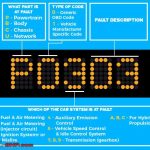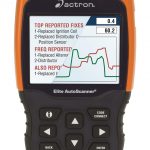If you are looking to fix your car, you need to understand what the obd fault codes mean. In this article, you will find the meaning of the most common obd fault codes, as well as the symptoms that come with these codes. So, how do you read the codes? Below are some useful tips. You may also find this article useful. If you are experiencing any of these symptoms, you should seek the help of a mechanic to resolve the problem.
Meaning of obd fault codes
In order to diagnose on-board vehicle problems, you need to understand the meaning of OBD fault codes. OBD codes consist of a combination of five different characters, each describing a different malfunction. The first two characters are single numbers, such as “P” and “F.” The fourth and fifth characters are pairs of numbers, ranging from 00 to 99. These codes are used to identify various issues, such as transmission or sensor failure.
The OBD system was first introduced in the early 1980s, and started illuminating a malfunction indicator light when a problem was detected. However, the codes used by different automotive manufacturers varied, making it difficult for mechanics to accurately diagnose the issue. To make the process easier, the OBDII specification was made mandatory for cars beginning in 1996. The OBDII standard specifies the type of diagnostic connector, the message format, and electrical signaling protocols used. The new standard paved the way for popular diagnostic tools.
In addition to this, OBD codes can be categorized into generic and manufacturer-specific versions. Codes with the first digit 0 are generic or global, and are used by most cars following the OBD2 standard. They are similar to each other, so they can be assigned the same fault message for most cars. Manufacturer-specific codes, on the other hand, are specific to a particular car model. It is also possible to interpret the meaning of a given DTC, as long as you understand how to interpret them.
Fortunately, modern cars are equipped with onboard diagnostic computers. These computers are used to diagnose a variety of problems and are capable of storing five-letter diagnostic trouble codes. OBD scanners are useful tools for identifying a malfunction and a solution. Using a diagnostic scanner, you can determine the exact problem. This information can save you a lot of money and time. A technician can use the information to make repairs quickly.
Besides diagnosing a vehicle’s problems, understanding the meaning of OBD fault codes is also essential for your own safety. By identifying what each of these codes means, you can take appropriate action to fix the problem. If you don’t know what an OBD code means, it might be time to call your mechanic or a mechanic. The good news is that there are dozens of ways to learn about the meaning of OBD codes.
A basic code reader provides a five-character code, which can be used to troubleshoot the problem. For more detailed information about what the code means, you can consult a standard DTC list or the manufacturer’s website. If you own a fleet of vehicles, however, you can purchase a sophisticated fleet management solution that provides a comprehensive code definition and fault alerts. Most code readers plug into the 16-pin OBD-II diagnostic connector, which is typically located under the dashboard. Older cars may require specific adapters.
List of common obd fault codes
OBD stands for onboard diagnostics. This system monitors the condition of your car’s engine and records faults as unique codes. Often, these codes indicate problems in the engine. They are also called diagnostic trouble codes and are used by mechanics to determine the source of car problems. Listed below is a list of common OBD fault codes and their meaning. This article will explain what each one means and how to fix it.
An OBD2 code does not necessarily mean that you should replace your vehicle’s 02 sensor. The code indicates that the oxygen sensing system is malfunctioning. This could be due to bad wiring, a faulty catalytic converter, a vacuum leak, or a plugged fuel injector. There are various causes of this trouble code, so it is important to know what the code means. A technician can use this code to make the necessary repairs to your vehicle.
A P0171 or P0174 OBD-II code means that your vehicle’s EVAP system is not functioning properly. The EVAP system prevents gas fumes from escaping into the air, thereby reducing air pollution. EVAP codes also monitor the vehicle’s idling and speed controls. The P0171 or P0174 code may indicate an issue with the vehicle’s speed sensor or a malfunctioning computer system. The P0174 code means that your engine has a problem with its air/fuel ratio.
There are two different types of OBD2 codes: generic and manufacturer-specific codes. Some of these codes start with a “1” while generic codes begin with a “2” or “3”. The first two digits specify the type of code, while the second and third digits indicate a specific system. A P0420 code indicates a problem with the catalytic converter. This code is not unique to any specific vehicle and is common in most cars.
The diagnostic trouble codes are stored in the Powertrain Control Module (PCM) when a problem is detected. These codes are designed to guide the mechanic to the exact problem area. They are displayed on the dashboard warning lights as the car’s computer recognizes a problem. The corresponding symptoms include dashboard indicator light malfunction, engine speed sensor trouble, and more. The OBD-2 codes can help diagnose the problem and guide repairs.
The powertrain codes generally cover engine, transmission, and drivetrain accessories. The U-codes category covers functions common to computer systems and other parts of the vehicle. Some trouble codes are general and some are manufacturer-specific. Generally, P codes are the same for all cars. So, if you see P0141 code in your dashboard, your car’s catalytic converter is probably the culprit. A malfunctioning catalytic converter will produce increased tailpipe emissions.
Fuel misfire codes indicate an engine issue. In some cases, the problem is fuel supply. The culprit could be a clogged fuel filter, faulty fuel pressure regulator, or bad pump. Some other possible reasons include major vacuum leaks and EGR valve problems. If this occurs, you should diagnose the other codes to pinpoint the exact cause. The code P0301-P0308 are individual cylinder misfire codes that show misfire.
Symptoms of obd fault codes
When diagnosing an on-board diagnostic error, it’s vital to understand the codes and their associated causes. A common example is the “P0171” code, which means the system is too lean (Bank 1). The O2 sensor detects excessive oxygen in the exhaust stream. This can result in poor power and gas mileage. The cause of this error code may include a faulty MAF sensor, a weak fuel pump or a failed fuel pressure regulator. Moreover, a malfunctioning O2 sensor may also be the cause of other fault codes.
When an OBD fault code is displayed, you may be wondering what exactly is wrong with your vehicle. You may not know what to do next. You can either hire a mechanic or repair it yourself. Many car repair shops offer diagnostic software that can help you troubleshoot the problem. However, if you are unsure about what to do, try the Internet and read reviews before you attempt any work.
If you suspect your car is having an engine problem, check for the Check Engine Light. The Check Engine Light will illuminate when a fault is detected in the monitored system. To check for these codes, use an OBD scan tool. Some tools will even tell you what the codes mean. This information is extremely helpful when it comes to fixing your vehicle. If you know the code, you will be able to determine if it’s a problem with the gas cap or another system.
The Diagnostic Trouble Codes are a standard feature of today’s vehicles. The OBD-ll standard specifies the dimensions of a 16-pin diagnostic connector, as well as the types of circuits, location, signal protocols, and more. It was introduced in 1991 and mandated that all new vehicles in the US have this interface. These standards have led to improved accuracy and diagnostic tools. There are a wide range of codes available, including symptom bytes and enhanced DTCs.
The first few letters of an OBD diagnostic trouble code represent powertrain problems. The first letter of the code corresponds to a specific subsystem or group of codes, while the other four letters correspond to different problems in the vehicle. Some fault codes are indicative of engine misfires, while others indicate an underlying system failure. The most common powertrain OBD2 trouble codes include P, T, and P.
The diagnostic trouble codes can be confusing, but knowing the causes of the codes and what they mean is crucial in repairing your car. These codes are categorized into generic and manufacturer-specific types. P0420 indicates that your car is experiencing a problem with the catalytic converter. If this is the case, your car needs to be inspected right away by a mechanic. And the best way to do this is to download an app.






